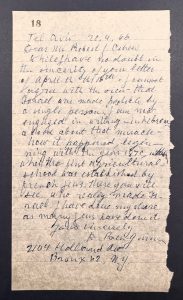The Palestine Exhibition Company, which was started in Illinois in 1887, created giant biblical panoramas of Jerusalem for a Christian audience. The company made three Jerusalem scenes which debuted in Chicago, Minneapolis and Buffalo, N.Y.
These panoramas (also called cycloramas) were the biggest paintings in the world (over 1,800 square meters) and were displayed in a 16-sided rotunda. They were a popular form of entertainment before the invention of motion pictures—a viewer would stand in the centre of the rotunda and witness an all-encompassing spectacle.
The Jerusalem panorama was based on an original work by the Munich artist Bruno Piglhein who went to Jerusalem in 1885 with two other artists. For one year they sketched and photographed the scenery in Jerusalem, which they imagined was little changed in 2,000 years. They made a point of painting the local people, who they believed were dressed as they would have been in the time of the New Testament, and then they returned to Munich to create their giant work.
When the panorama was opened to the public in May 1886, it was greeted with great acclaim, with biblical scholars admiring the accuracy of the detail. After three years, it moved from Munich to Berlin and from there to Vienna where it was destroyed by a fire. Fortunately, a number of copies of the massive painting had been made including the three by the Palestine Exhibition Company.
Another copy of the Jerusalem panorama that initially toured Europe was exhibited in Montreal before being set up as a permanent exhibition at Ste-Anne-de-Beaupre (outside of Quebec City) in 1895. It is one of only 17 surviving 19th-century panoramas in the world, and the third oldest in its original rotunda.
This certificate is for five shares issued in 1888 for $100 each (the equivalent of $3,300 today). It includes a drawing of the Temple in Jerusalem from the perspective of Christian theology.
Jerusalem has been the subject of fascination for thousands of years, with the panoramas being just one example of this phenomenon. Jerusalem is known as the City of Peace. Here’s hoping that in 2025 the city can live up to that lofty aspiration.







